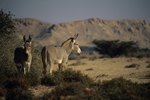American Bashkir Curly horses don't just have curly manes -- the rest of the hair on their bodies also includes a wave. Their manes split down the middle, with ringlets or waves cascading on both sides of the neck. Curls aren't the only thing the breed has going for them. They're physically tough but very affectionate equines. If you're creative, collect your horse's curly hair during shedding season for weaving or spinning.
Origins
Depictions of curly maned and coated horses date back to ancient China. The American Bashkir Curly Horse Registry states that the breed name was decided upon based on a 1938 photo of a curly-coated Bashkir Russian horse. However, the American version actually dates from the early 19th century, when the Sioux and Crow Indian tribes were known to possess such animals. At the end of the century, members of the Damele family witnessed these curly horses in central Nevada's high country. Modern Bashkir curlies trace back to the Damele herd.
Breed Standards
American Bashkir Curlies appear in any color. A medium-sized, sturdy animal, the curly boasts unusually round, hard black feet. The legs are well-boned with short cannons. In height, curlies range between 13.3 to 16 hands, with those below 14.2 hands considered ponies. They weigh between 800 and 1,200 pounds. The back is strong and short, while the neck is medium length. In basic conformation, they resemble the Morgan horse, another American breed with great versatility.
Hair
Registered American Bashkir Curly horses should have soft, fine hair on their bodies, with a range of waviness. Ringlets might be several inches in length, while the marcel wave resembles that human hair-do, consisting of a deep, soft wave. Crushed velvet feels like that type of fabric, with dense, soft piling. The preferred mane and tail standard calls for kinky curls, but wavy is acceptable. Be prepared: substantial portions of the mane and tail might shed in summer, growing back come fall.
Hypoallergenic
If you or someone in your life love horses but their presence causes sneezing and wheezing, it's possible a curly horse won't produce that reaction. A curly horse's hair resembles mohair, like that of an Angora goat, rather than typical horsehair. According to the American Bashkir Curly Horse Registry, a curly horse's hair is round rather than flat, as with ordinary horses. Allergy sufferers should spend a significant amount of time with a prospective curly horse purchase to make sure there's no reaction.
There's also the issue of care. If you must keep your curly horse in a boarding barn with regular horses, the other equines will trigger your allergies.
References
Writer Bio
Jane Meggitt has been a writer for more than 20 years. In addition to reporting for a major newspaper chain, she has been published in "Horse News," "Suburban Classic," "Hoof Beats," "Equine Journal" and other publications. She has a Bachelor of Arts in English from New York University and an Associate of Arts from the American Academy of Dramatics Arts, New York City.


